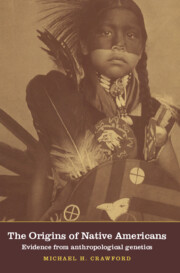Book contents
- Frontmatter
- Contents
- Preface
- Acknowledgement
- 1 Origins of New World populations
- 2 Population size and the effects of European contact
- 3 Demography of Amerindian populations
- 4 Genetic variation in contemporary populations of the Americas
- 5 Population structure of Native Americans
- 6 Morphological variation
- 7 The survivors
- References
- Author index
- Subject index
3 - Demography of Amerindian populations
Published online by Cambridge University Press: 01 May 2010
- Frontmatter
- Contents
- Preface
- Acknowledgement
- 1 Origins of New World populations
- 2 Population size and the effects of European contact
- 3 Demography of Amerindian populations
- 4 Genetic variation in contemporary populations of the Americas
- 5 Population structure of Native Americans
- 6 Morphological variation
- 7 The survivors
- References
- Author index
- Subject index
Summary
INTRODUCTION
The demography of human populations consists in part of their quantitative characteristics, including age/sex structure, size, fertility, mortality and migration patterns. The interrelations between fertility, mortality, emigration and immigration rates permit predictions of the numerical changes that a population may undergo during specific periods. For example, in reproductively closed populations such as species, the relative magnitudes of fertility versus mortality alone determine the size of the population. However, in most human populations it is the interaction of fertility and immigration versus mortality and emigration that determine the numerical trends in population size. This chapter considers the demographic structure of Amerindian populations both before European Contact and today. Given the broad scope of this volume, encompassing all of the indigenous peoples of the Americas and a heterogenous melange of populations of different sizes and subsistence patterns, it is not possible to reconstruct the demographic characteristics population by population. Instead, I shall endeavor to distill some of the common denominators of Amerindian populations. In addition, I shall present some examples that are particularly informative about the processes acting upon the demographic structures of these populations.
DEMOGRAPHY OF PRE-COLUMBIAN AMERINDIANS
The demographic characteristics of the populations of the Americas, prior to European contact, are often estimated from small amounts of information. There are no censuses or vital registers, both sources of data traditionally utilized by demographers. Instead, archeologists and biological anthropologists reconstruct the dynamics of prehistoric populations through the use of cultural artifacts, skeletal remains and the extrapolation of models derived from contemporary populations.
- Type
- Chapter
- Information
- The Origins of Native AmericansEvidence from Anthropological Genetics, pp. 63 - 87Publisher: Cambridge University PressPrint publication year: 1998



